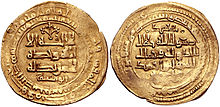Muhammad of Ghazni
| Muhammad | |
|---|---|
 |
|
| Sultan of the Ghaznavid Empire | |
| Reign | 1030-1030 1040-1041 |
| Predecessor | Mahmud of Ghazni |
| Successor | Mas'ud I of Ghazni |
| Born | 998 Ghazni (now in Afghanistan) |
| Died | 1041 Ghazni |
| Burial | Ghazni |
| Consort | Daughter of Abu'l-Nasr Muhammad |
| Issue | 'Abd al-Rahman Ahmad |
| House | Ghaznavids |
| Father | Mahmud of Ghazni |
| Religion | Sunni Islam |
Muhammad of Ghazni (Persian: محمد غزنوی) (died 1041) was sultan of the Ghaznavid Empire briefly in 1030, and then later from 1040 to 1041. He ascended the throne upon the death of his father Mahmud in 1030. He was the younger of a set of twins; this circumstance resulted in civil strife. His reign lasted five months before he was overthrown by his twin Ma'sud I, after which he was blinded and imprisoned. Nine years later he was reinstated for a year before being slain by his nephew Maw'dud. According to Ferishta, his reign lasted only 50 days before he was blinded and imprisoned on the order of Ma'sud I. A year later he was murdered by his nephew Maw'dud.
Mohammed was born along with his elder twin brother Mas'ud in 998 at the Ghaznavid capital of Ghazni. In ca. 1008, Mohammad married the daughter of the Farighunid ruler Abu'l-Nasr Muhammad. Two years later after the death of Abu'l-Nasr Muhammad, Mohammad was appointed by his father as the governor of Guzgan, thus putting an end to the native Farighunid dynasty of Guzgan.
In 1030, Mahmud, because of his bad relations with his heir Mas'ud, changed his opinion, and appointed Mohammad as his heir, who was much less experienced in government and military affairs than Mas'ud. Mahmud shortly died, and was succeeded by Mohammad, who then appointed Abu Sahl Hamduwi as his vizier. At his accession, much power of the state was under the former vizier Hasanak Mikali and military officer Ali ibn Il-Arslan, who greatly administered the state. Muhammad shortly appointed his uncle Yusuf ibn Sabuktigin as the commander-in-chief of the army. Although Muhammad did not possess any real power, his empire flourished. Soon, however, Muhammad's slave troops (ghulam) railed under Abu'l-Najm Ayaz, who had openly changed his allegiance to Muhammad's brother Mas'ud, whose military campaigns in western Iran had earned him a great reputation. Ayaz was shortly joined by other military officers such as Ali Daya. Muhammad then sent an army under his general Suvendharay to quell the rebellion, but the rebels eventually emerged victorious and killed Suvendharay. The victorious rebels then went to Mas'ud, who was at Nishapur.
...
Wikipedia
